
Welcome
Welcome to Dan Becker's Guitars and Music Site, a personal web site with articles on playing the guitar, music theory, guitar chords and scales, performances, technical investigations, and helpful hints. This page contains a number of music theory charts and their explanations. The Guitars home page is the parent page of this document, and the Performances Charts page is a commonly requested page on this site.
Music Charts Quick List
This section lists the charts with no explanation and no images. Scroll down below to get more details and small preview of each chart.
- Big Chord Chart (explanation) - common chords and moveable chord shapes.
- CAGED Forms Chart (explanation) - 6 forms to play C, A, G, E, D major and minor chords.
- Big Scales Chart (with fingering) (explanation) - 5 forms each for major, minor, pentatonics, blues, and country blues with finger placements.
- Big Scales Chart (with note degrees) (explanation) - 5 forms each for major, minor, pentatonics, blues, and country blues with scale degrees.
- Triad Arpeggios Chart (explanation) - 5 forms each for major, minor, diminished, augmented, suspended 2 and 4 triads.
- Seventh Arpeggios Chart (explanation) - 5 forms each for major 7th, dominant 7th, augmented 7th, minor 7th, minor 7th flat 5, diminished 7th.
- Triad Chords Chart (explanation) - 5 forms each for major, minor, diminished, augmented, suspended 2 and 4 triads. Roots and inversions color coded.
- Seventh Chords Chart (explanation) - 5 forms each for major 7th, dominant 7th, augmented 7th, minor 7th, minor 7th flat 5, diminished 7th. Stock Seventh Chord open voicings highlighted in yellow.
- Mode Scales for G (explanation) - 7 mode scales for G. This chart shows Ionian, Dorian, Phrygian, Lydian, Mixolydian, Aeolian, and Locrian scales for G.
- Harmonized 7th Chords (explanation) - shows harmonized 7th chords progressions with stock fingerings.
- Major and minor pentatonics (explanation) - shows relation of major and minor pentatonics on the fretboard.
- Ninths (explanation) - shows CAGED forms of various ninths chords.
Music Charts Detailed List
Below is a list of the articles, charts, and cheat sheets I've made on playing guitar and music theory. Click on the image or the link to view or download the chart. Note that many charts have a transparent background layer and will let the print paper show through. On some image viewers the chart might appear strange with a black or colored background. Set the background to white, or resave the chart with no transparency to make this go away. More articles and charts are on the way.
-
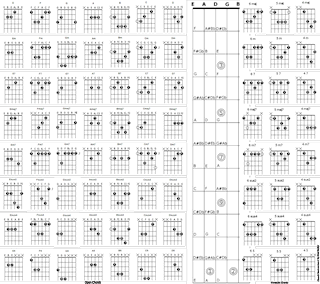
Dan's Big Chord ChartThis chart shows a large number of open and moveable chords. To the left of the guitar fretboard are many common open chords, arranged in columns by chord letter E-F-G-A-B-C-D. Horizontally the diagrams represent chord types, for example major, minor, seventh, sustained. To the right of the guitar fretboard are common moveable chords, arranged in columns by 6, 5, and 4 string versions. Notes on the fretboard help you remember where to move the chord.
-
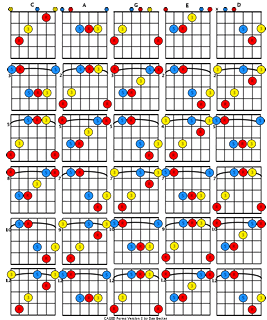
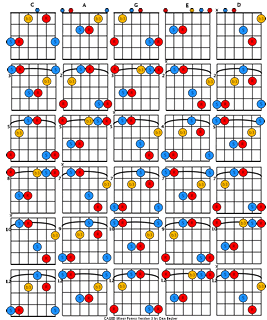
Dan's CAGED Forms Chart - major chords
Dan's CAGED Forms Chart - minor chordsThese charts shows the common chord shapes for C, A, G, E, and D, also known as the CAGED chords. The first chart shows the open and moveable forms of the CAGED major chord shapes, For instance, not only do you see the open C chord, you also see the barred C chord at the 2nd, 4th, 7th, 9th, and 12th frets which let you play the D, E, G, A, and C forms of the chord. The second chart shows the open and moveable forms of the CAGED minor chord shapes.
Each chord shows the degree of the note in color. Roots are colored red, thirds yellow, flat/minor thirds in orange, and fifths in blue. Use these charts to improve your hand strength and play chords at different parts of the fretboard. Play the chords horizontally, vertically, and diagonally for a good workout. You can also get nice chord voicings by playing partial chords, for example the top three strings. Some chords are most recognizable when the root note is the first string played. (Here is an older version of the chart that gives CAGED finger placements.)
-

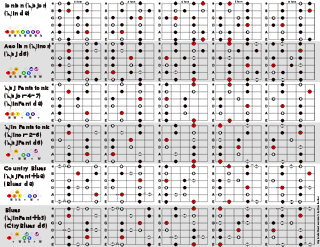
Dan's Big Scales Chart (with note degrees)
Dan's Big Scales Chart (with fingering)These charts shows notes for many common scales - Major, Minor, Major and Minor Pentatonics, Blues, and Country Blues (also known as Relative Blues, or Inverted Blues). The first chart has notes annotated with finger placements. The second chart has notes annotated with degrees of important notes. For example, the Major scale row shows Rs, 3s, and 5s, which are the roots, thirds, and fifths of each octave. On the left is the name of the scale along with a handy little graphic showing the step intervals from note to note (for example the major scale has intervals whole-whole-half-whole-whole-whole-half). The colored notes show which of the 12 notes of the diatonic scale are included in the chord. For instance, the minor scale has the root, 2nd, minor 3rd, 4, 5, flatted 6th, and flatted 7th notes. Then each CAGED form of the scale is shown along with numbers showing where to place your fingers. Roots are shown in red. Notice how the scale forms are repeated on different rows. In fact the major and minor row shapes are the same form, shifted one column, and with the roots in a different place. One additional change is on this chart is the position of the blues scales. This emphasizes the similarity of the Major, Major Pentatonic, and Country Blues scales on the first, third, and fifth row. There is also similarity of the Minor, Minor Pentatonic, and Blues scales on the second, fourth, and sixth rows. Since the Blues scales can span 5 frets, these scales have a little <> notation which means to shift your hand position up or down, or a little ^ notation which says you can get the note with an extension of your index or pinky finger. Use this chart to practice scales and important triads.
-
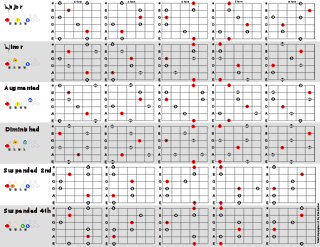
Dan's Triad Arpeggios ChartThis chart shows fingerings for triad arpeggios, common three note sets that make up chords. Each row shows a triad type, and the intervals for the triad. There are major triads (1-3-5), minor triads (1-b3-5), augmented (1-3-#5), diminished (1-b3-b5), suspended 2nd (1-2-5), and suspended 4th (1-4-5). Each column shows one of the C, A, G, E, D box forms for playing the triads. Roots are shown in red with the letter R. Other notes have the note number. Notice how the upper part of one form is the same as the lower part of the next form. They interlock.
-

Dan's Seventh Arpeggios ChartThis chart shows fingerings for seventh arpeggios, four note sets that make up nice scales and basic chords. Each row shows a seventh type, and the intervals for the seventh. There are major 7ths (1-3-5-7), dominant 7ths (1-3-5-b7), augmented 7ths (1-3-#5-b7), minor 7ths (1-b3-5-b7), minor 7ths, flat 5ths (1-b3-b5-b7), and diminished 7ths(1-b3-b5-bb7). Each column shows one of the C, A, G, E, D box forms for playing the triads. Roots are shown in red with the letter R. Other notes have the note number. Notice how the upper part of one form is the same as the lower part of the next form. They interlock.
See the Seventh Chords chart section below for a similar chart with the stock Seventh Chord open voicings highlighted in yellow.
-

Dan's Triad Chords ChartThis chart is a dense reference work for people who like to play triads (chords consisting of 3 notes). Each row shows a triad type, and the intervals for the triad. The left hand side by the triad name also shows the note forumula in a rainbow colored note chart and also the intervals between the notes (e.g. whole step or half step). There are major triads (1-3-5), minor triads (1-b3-5), augmented (1-3-#5), diminished (1-b3-b5), suspended 2nd (1-2-5), and suspended 4th (1-4-5). The right side of the chart shows finger positions on the neck for a D version of the triad, and so you see the root notes in the same position for all triads. Roots are shown in red with the letter R. Other notes have the note number.
Colored boxes outline each triad chord. Root triads (1-3-5) are outlined with a red box. First inversions (3-5-1) are outlined with a green box. Second inversions (5-1-3) are outlined with a blue box. Unlike triad arpeggios, triad chords must be played on different strings, and so there are 4 of each box on a fretboard diagram, one for each 3 string triad chord starting on the E, A, D, and G strings. Some fretboards have 5 boxes because the shapes repeat themselves as you move toward the bridge and higher than the 12 fret. At the lower part of the fretboard, some colored brackets span each of the 5 chord shapes (CAGED shapes) that define the fretboard.
This is an incredible 72 triad chords on one reference sheet. It is very dense, but it makes a useful practice and visualization aid.
-
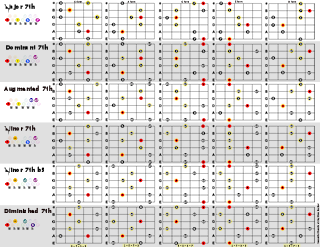
Dan's Seventh Chords ChartSimilar to the Seventh Arpeggio chart above, this chart shows fingerings for seventh arpeggios, four note sets that make up nice scales and basic chords. Each row shows a seventh type, and the intervals for the seventh. There are major 7ths (1-3-5-7), dominant 7ths (1-3-5-b7), augmented 7ths (1-3-#5-b7), minor 7ths (1-b3-5-b7), minor 7ths, flat 5ths (1-b3-b5-b7), and diminished 7ths(1-b3-b5-bb7). Each column shows one of the C, A, G, E, D box forms for playing the triads. Roots are shown in red with the letter R. Other notes have the note number.
Additionally, this chart shows 4 note stock Seventh Chord open voicings highlighted in a subtle transparent yellow. Open voicings occur when you raise or lower a note by an octave to make it easier to play. This is common with seventh chords where the seventh note occurs so close to the next root. Notice at the bottom of each pattern column is the name of the stock voicing: 3-7-1-5, 1-5-7-3, 5-1-3-7, 1-7-3-5, and 1-5-7-3. Also notice that the C form roots are always on the 2nd string, the A form roots are on the 5th string, G form roots are on the 3rd string, E form roots are on the 6th string, and D form roots are on the 4th string. Grab a pattern near the string you are playing on. Some of them have a four fret span and are tough to play, but others are good to know and add useful variations to common open chords.
-
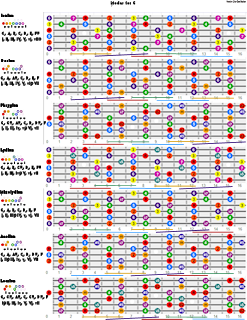
Dan's Mode Scales for GThis chart shows all seven modes for the key of G. Why G and not one of the other 12 notes? Well, G is nice and low on the sixth string without requiring open notes for the first hand position. Here is an explanation for this mode chart.
A C major scale consists of 8 notes starting and ending at C with note intervals corresponding to the white keys of a piano. (Whole step, whole, half, whole, whole, whole, half.) An A minor scale consists of 8 notes starting and ending at A with note intervals also corresponding to the white keys of a piano. (Whole step, half, whole, whole, half, whole, whole.) The notes are the same, but because the intervals from note to note occur in a different order, the two scales have a decidedly different sound.
The seven modes in classical western music correspond to the seven possible sequences of the steps in the major scale. The scales are named Ionian, Dorian, Phrygian, Lydian, Mixolydian, Aeolian, and Locrian. The Ionian scale is another name for the major scale, and the Aeolian is another name for the minor scale. If you number the Ionian/major scale intervals (W, W, h, W, W, W, h) one to seven and make a scale starting on each number and looping around back to the start, you produce the seven modal scales. For instance, the intervals for a Dorian scale are W, h, W, W, W, h, W which is the major scale sequence but starting on the second interval. Although they are the same intervals as a major scale, they have a different sequence and a different sound to them.
Each row shows one of the seven modes. On the left is the mode name, a rainbow colored diagram of the notes in the scale, a textual sequence of the whole and half step intervals, a list of the notes in the scale, and a chord progression based on the scale notes. The chords are capitalized for major, lower case for minor, and degreed for augmented chords. On the right is a large fretboard of all notes in the scale. The note colors show the degree of the note. Below the fretboard are colored bars which show a hand position and form for one of the CAGED system boxes. The fretboards are generated by the Gootar web site.
Notice that by changing the hand-position/form for the low G, you cycle around the modes. For instance, the left-most form for Ionian/major fretboard is the E form (colored with a yellow bar here). The left-most form for Dorian fretboard is the D form (colored with a purple slanted bar). And so the lowest G forms rotate (and shift slightly) to give you seven modes. Similarly, if you follow a hand-position/form through the modes, you see the root travel through different steps in the form. For example, the A hand-position/form (colored with a green bar) on the Ionian scale covers the 9th through 12th frets with the fifth string G root occurring on the 10th fret, and the lowest note on that position is a fifth. The A form (green bar) on the Dorian scale covers the 7th through 10th frets Again the G root is on the 10th fret, but the lowest note on that position is a fourth.
-
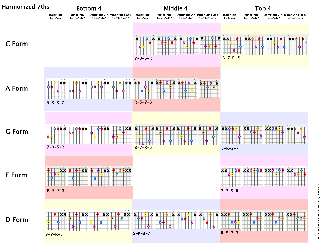 Harmonized Seventh
Chords
Harmonized Seventh
Chords
This chart shows 12 sets of harmonized seventh chords. These chords sound pleasing together, and add variety or tension when you play them instead of a basic major or minor chords.
Each set of 4 fretboards shows the following seventh chord types: major 7th, minor 7th, dominant 7th, and minor 7th flat 5. Each row shows CAGED forms of these seventh chords. Each column of sets is grouped by string placement on the guitar: bottom 4, middle 4, or top 4 strings.
A harmonized chord progression contains seven chords in a particular key following the progression I - ii - iii - IV - V - vi - vii - I. The I and IV chords are major 7ths. The ii, iii, and vi are minor 7ths. The V is the dominant 7th, and the vii is the minor 7th with a flat 5th. Play the chords in the set in the order major-minor-minor-major-dominant-minor-minor-b5-major. Follow the W-W-h-W-W-W-h interval formula to go from root to octave and place each chord in the formula on the fretboard. Use the root of the chord to name the chord.
For example, the rightmost 4 chords on the bottom row (shaded red) are a common stock chord set for the D form on the upper 4 strings. If you play the major 7th pattern in the zero or open position, the root falls on the open D string, and makes the D form of the D major 7th chord. Following the W-W-h-W-W-W-h formula, move up the fretboard two half steps (two frets) and you are playing the E minor 7th chord. Move up two more frets, and you are playing the F# minor 7th. Move up one fret and play the major again to play the G major 7th. Move up two frets and play the dominant 7th to play the A 7th. Move up two frets and play the minor 7th to play the B minor 7th. Move up one fret and play the minor 7th flat 5 C m7b5 7th. Finally end the progression by moving up two frets and play the root major 7th again at D major 7th on the 12th fret. Notice you have just played the harmonized D progression D-Em-F#m-G-A7-Bm-Cm°-D.
Finally notice that the chord sets are grouped by inversion patterns. The R-3-5-7 patterns are shaded red. The 7-3-5-R patterns are violet, the 5-R-3-7 patterns are blue, and the 3-7-R-5 patterns are shaded yellow. For learning these sets, I suggest you start with the red R-3-5-7 sets. Then move to the violet 7-3-5-R sets. Experts can take on the rest.
-

Major and Minor PentatonicsThis chart shows the positional relationships of CAGED fingerings in the major and minor form.
The odd rows show the major scales for C, A, G, E, and D for the full guitar fretboard. Roots are shown in red, and other note degrees have an individual color. The fourth and seventh degree notes are grayed out to emphasize the shapes of the major pentatonic scale patterns. The odd rows are also labeled with the relative minor scale names Am, F#m, Em, C#m, and Bm. The relative minor of a major pentatonic scale can be played by starting one note down in the scale. For example, the A minor pentatonic scale can be played by using the C major pentatonic scale and starting one note earlier down the scale.
The even rows show the minor scales for C, A, G, E, and D. Again, roots are shown in red, and other note degrees have an individual color. The second and sixth degree notes are grayed out to emphasize the shapes of the minor pentatonic scale patterns. Notice that the even and odd rows have roots and fifths and other note degrees in the same positions. However the shapes move up 3 frets when changing from major to minor pentatonics. For instance, the 6 string shape at fret 5 of C major moves up to fret 8 on A minor.
This is quite a big chart. I hope that the relationships and repetitions come through by getting familiar with it.
Much of this chart was generated with the Gootar site. I highly recommend you visit and try that guitar site. This chart replaces the Major and minor relative chart.
-
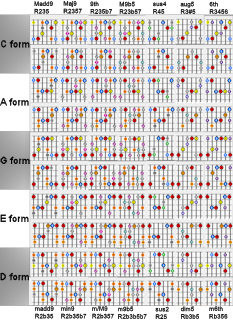
NinthsThis chart shows the CAGED forms of some ninth chords and related chords. Each of the 5 forms have two rows of 7 chords. The top row shows predominantly major chords and the second row shows minor chords. Each colored note on the fretboard shows a note that fits into the chord formula. Ghostly gray notes relate the pattern to other patterns nearby.
The major chord row shows the following formulars:
- Major Add 9 - R-2-3-5
- Major 9th - R-2-3-5-7
- Dom 9th - R-2-3-5-b7
- Major 9th, flat 5 - R-2-3-b5-7
- Sus 4 - R-4-5
- Aug 5 - R-3-#5
- Major 6th - R-3-5-6
The minor chord row shows the following formulars:
- Minor Add 9 - R-2-b3-5
- Minor 9th - R-2-b3-5-b7
- Minor/Major 9th - R-2-b3-5-7
- Minor 9th, flat 5 - R-2-b3-b5-b7
- Sus 2 - R-2-5
- Dim 5 - R-b3-b5
- Minor 6th - R-b3-5-6
What are you waiting for? Click on the chart and start playing like a genius.
If you like these articles on guitars and music, and you find a site that might be helpful in explaining how the guitar or music works, please send it to me, and I will share it with all the readers.